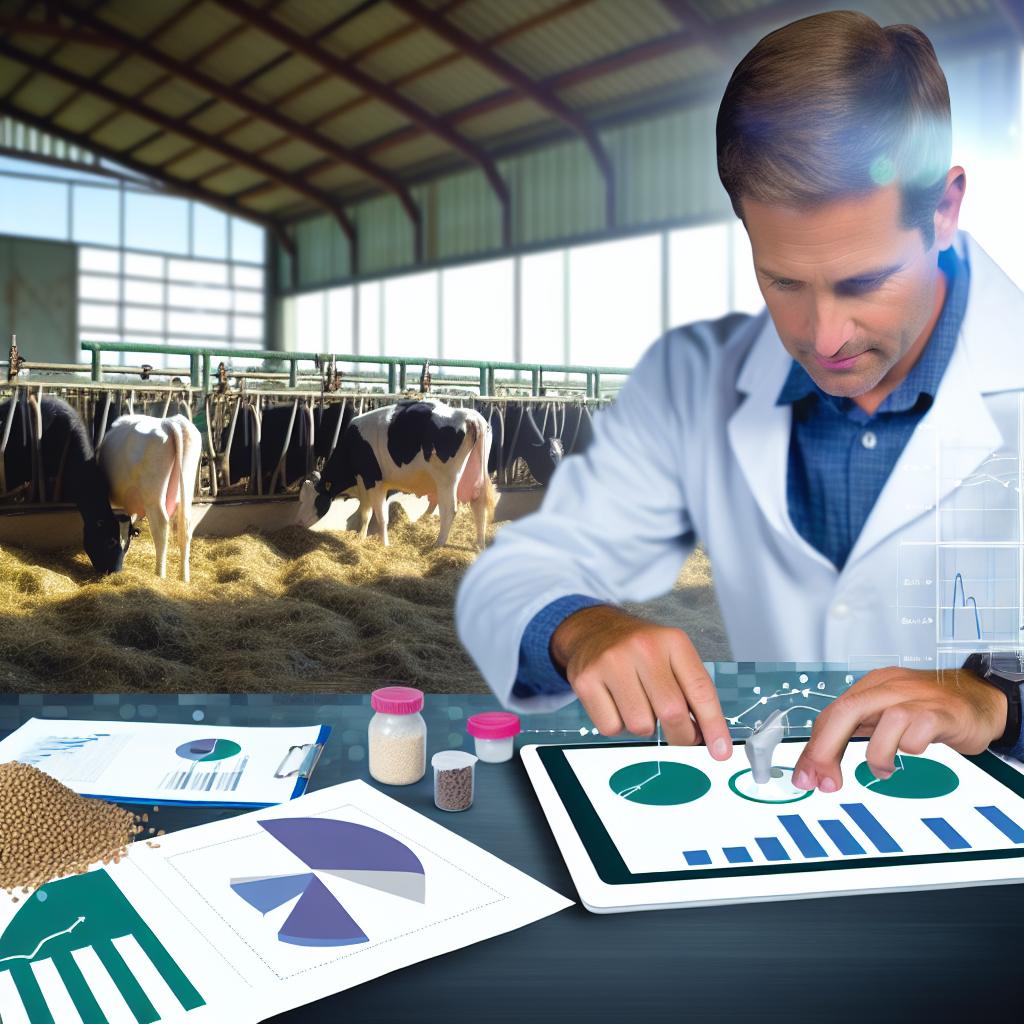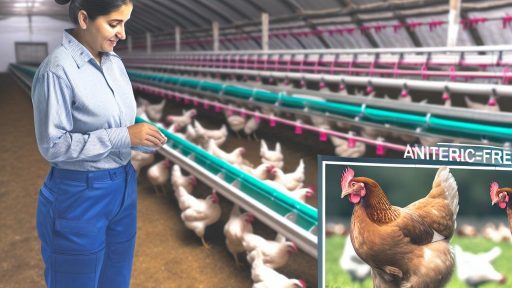Understanding Feed Conversion Efficiency
Definition of Feed Conversion Efficiency
Feed conversion efficiency measures how well livestock convert feed into body mass.
This ratio is crucial for assessing the productivity of animals in agriculture.
Higher efficiency means more gain with less feed, thus saving costs.
Importance of Feed Conversion Efficiency
Feed conversion efficiency directly impacts profitability in livestock production.
Improving this efficiency reduces feed costs, which are a major expense for farmers.
Additionally, optimized feed usage leads to better environmental sustainability.
It decreases waste and minimizes the carbon footprint of livestock operations.
Factors Influencing Feed Conversion Efficiency
Several factors affect feed conversion efficiency in livestock.
Nutritional quality of feed plays a vital role in animal performance.
For example, balanced rations enhance growth and overall health.
Genetics and breed also significantly influence an animal’s conversion ability.
Furthermore, management practices can either improve or hinder efficiency.
Strategies to Improve Feed Conversion Efficiency
Farmers can adopt various strategies to enhance feed conversion efficiency.
Implementing proper nutrition is essential for maximizing growth.
- Utilize high-quality feed ingredients for balanced nutrition.
- Monitor and adjust diets based on growth stages.
- Consider using feed supplements to improve digestibility.
Additionally, adopting advanced breeding techniques helps select for better performers.
Transform Your Agribusiness
Unlock your farm's potential with expert advice tailored to your needs. Get actionable steps that drive real results.
Get StartedInvesting in technology such as precision feeding allows tailored diets.
Finally, regular health assessments ensure that animals perform at their best.
Key Nutritional Components Affecting Feed Conversion in Livestock
Energy Sources
Energy sources are crucial for optimal livestock performance.
Carbohydrates are the primary energy component in livestock diets.
Fats also provide high-density energy and contribute to growth efficiency.
Understanding the energy requirements is vital for enhancing feed conversion.
Proteins and Amino Acids
Proteins are essential for muscle development in livestock.
Amino acids play a key role in protein synthesis and overall health.
Providing a balanced amino acid profile improves feed efficiency.
Animal growth rates and productivity depend on adequate protein intake.
Vitamins and Minerals
Vitamins and minerals support various bodily functions in livestock.
Minerals like calcium and phosphorus are crucial for bone development.
Trace minerals such as zinc and selenium enhance immune function.
Adequate vitamin intake promotes reproduction and feed utilization.
Fiber Sources
Fiber is a critical component for ruminant digestion and fermentation.
High-fiber feeds improve gut health and microbial balance.
Including the right fiber sources can prevent digestive disorders.
Adequate fiber supports overall digestion and feed efficiency.
Feed Additives
Feed additives can enhance nutrient absorption in livestock.
Probiotics improve gut health and promote nutrient utilization.
Enzymes in feed can break down complex nutrients for better absorption.
Strategically using additives can lead to improved feed conversion rates.
Role of Protein Quality and Quantity in Enhancing Feed Efficiency
Protein plays a crucial role in livestock nutrition.
Quality and quantity of protein directly affect feed efficiency.
Showcase Your Farming Business
Publish your professional farming services profile on our blog for a one-time fee of $200 and reach a dedicated audience of farmers and agribusiness owners.
Publish Your ProfileLivestock require high-quality protein for optimal growth.
Protein quality refers to the amino acid profile of feed.
Complete proteins contain all essential amino acids.
Incomplete proteins lack one or more essential amino acids.
High-quality protein sources improve animal performance.
Examples include soybean meal and fish meal.
These sources provide better amino acid profiles than others.
Moreover, protein quantity in the diet influences growth rates.
Higher protein levels can lead to increased weight gain.
However, excessive protein may result in nitrogen waste.
This waste can harm the environment and reduce profitability.
Balancing protein quality and quantity is essential.
This balance maximizes feed conversion efficiency.
Livestock producers should analyze their specific needs.
Feed formulations must consider the animal’s growth stage.
Different stages require varying protein levels.
For example, young animals need higher protein concentrations.
This supports their rapid growth and muscle development.
In contrast, mature livestock might require lower levels.
Furthermore, the digestibility of protein is vital.
Highly digestible proteins enhance nutrient absorption.
For improved performance, include a variety of protein sources.
Integrating plant and animal proteins can be beneficial.
Lastly, regular evaluation of feed formulations is necessary.
This ensures alignment with the livestock’s nutritional needs.
See Related Content: Livestock Nutrition for Maximizing Meat and Dairy Production
Impact of Energy Sources on Livestock Nutrition and Feed Conversion Rates
Role of Energy in Livestock Nutrition
Energy serves as a fundamental component of livestock nutrition.
It influences growth, reproduction, and overall health.
Moreover, energy impacts the feed conversion efficiency directly.
Higher energy levels improve the weight gain of livestock.
In contrast, insufficient energy leads to weight loss and poor health.
Types of Energy Sources
Various energy sources are available for livestock diets.
Common energy sources include grains, forages, and fats.
Each source has distinct nutritional profiles and benefits.
For instance, grains provide high digestible energy.
On the other hand, fats offer concentrated energy but may slow digestion.
Optimizing Energy Sources for Feed Conversion
Selecting optimal energy sources enhances feed conversion rates.
Nutritionists often balance grain and forage in diets.
A proper balance promotes efficient digestion and nutrient absorption.
Additionally, adding fat can improve the overall energy density.
Showcase Your Farming Business
Publish your professional farming services profile on our blog for a one-time fee of $200 and reach a dedicated audience of farmers and agribusiness owners.
Publish Your ProfileThis results in better growth rates and weight gain in livestock.
Impact of Energy Quality on Feed Efficiency
Energy quality is just as crucial as energy quantity.
High-quality energy sources improve feed conversion efficiency significantly.
They enhance nutrient availability and support metabolic functions.
Moreover, they reduce the amount of feed needed for weight gain.
Ensuring high energy quality can lead to reduced production costs.
Key Considerations for Farmers
Farmers should monitor livestock energy needs regularly.
Adjustments may be necessary based on growth stages and production goals.
Also, consider seasonal variations in forage quality and availability.
Feeding strategies should adapt to changing conditions for optimal results.
Finally, incorporating supplements can help meet energy requirements efficiently.
Discover More: Organic Livestock Farming for Meat Production
Vitamins and Minerals: Their Role in Optimizing Livestock Performance
Essential Vitamins for Livestock
Vitamins play a crucial role in livestock nutrition.
They contribute to overall health and vitality.
Vitamin A is vital for growth and vision.
Additionally, it supports the immune system.
Vitamin D promotes calcium absorption.
Consequently, it aids in bone health.
Vitamin E acts as an antioxidant.
This function reduces oxidative stress.
Key Minerals in Livestock Diets
Minerals are equally important for livestock nutrition.
Calcium and phosphorus are essential for bone development.
Both minerals promote strong skeletal structure.
Sodium supports nerve function and hydration.
Magnesium is vital for muscle function.
Likewise, zinc enhances immune response.
The Importance of Balanced Nutrition
A balanced diet maximizes livestock performance.
It improves feed conversion efficiency significantly.
When vitamins and minerals are balanced, animals thrive.
Consequently, they exhibit higher growth rates.
Furthermore, optimal nutrient intake enhances reproduction.
Deficiency Symptoms in Livestock
Deficiencies can lead to serious health issues.
For instance, vitamin A deficiency causes poor growth.
It also results in vision problems in livestock.
Mineral deficiencies can cause severe reproductive issues.
Inadequate calcium results in weak bones.
Supplementation Strategies
Supplementing diets can address nutrient deficiencies.
Using high-quality feed additives ensures nutritional balance.
Specific vitamin and mineral supplements target deficiencies.
Therefore, consulting a nutritionist is advisable.
Showcase Your Farming Business
Publish your professional farming services profile on our blog for a one-time fee of $200 and reach a dedicated audience of farmers and agribusiness owners.
Publish Your ProfileProperly formulated supplements enhance overall performance.
Uncover the Details: Importance of Water Quality and Hydration in Swine Rearing
Evaluation of Feed Additives and Their Effects on Nutritional Absorption
Introduction to Feed Additives
Feed additives play a crucial role in livestock nutrition.
They enhance feed quality and improve nutrient absorption.
Moreover, their use can boost overall animal health.
Types of Feed Additives
Several categories of feed additives exist in the market.
These include vitamins, minerals, enzymes, and probiotics.
Each type serves a unique purpose in animal nutrition.
Vitamins and Minerals
Vitamins and minerals are essential for growth.
They support metabolic processes and reproductive performance.
Deficiencies in these nutrients can lead to health issues.
Enzymes
Enzymes assist in the digestion of feed components.
They improve the breakdown of carbohydrates, proteins, and fats.
Consequently, this can lead to better nutrient utilization.
Probiotics
Probiotics promote a healthy gut microbiome.
These beneficial bacteria enhance digestion and nutrient absorption.
In turn, they support immune function and overall wellness.
Effects on Nutritional Absorption
Feed additives can significantly influence nutrient absorption rates.
By improving digestive efficiency, they enhance performance outcomes.
For instance, enzyme additives can break down complex nutrients.
Research Findings on Feed Additives
Studies show a marked improvement in weight gain.
Additionally, feed conversion ratios often improve with additives.
This means animals require less feed for the same weight gain.
Integrating Feed Additives into Diets
Farmers should consider integrating feed additives into diets.
By doing so, they can maximize growth potential and health.
Regular assessments will help determine the best combinations.
Learn More: Weed Control Methods for Maintaining High-Quality Pastures

Strategies for Formulating Balanced Rations to Improve Feed Conversion
Understanding Nutritional Requirements
Livestock require a balanced diet for optimal performance.
Nutritional needs vary based on species and growth stage.
It is essential to conduct regular feed analyses.
Identifying deficiencies helps in formulating effective rations.
Formulating Balanced Rations
Balanced rations should contain all essential nutrients.
These include proteins, carbohydrates, fats, vitamins, and minerals.
Start by selecting high-quality feed ingredients.
Incorporating a variety of feeds can enhance nutrient diversity.
Work with a nutritionist to design precise formulations.
Utilizing Feed Additives
Feed additives can significantly improve feed conversion.
Common additives include enzymes, probiotics, and amino acids.
Each plays a role in enhancing digestion and nutrient absorption.
Careful integration of these additives is necessary.
Showcase Your Farming Business
Publish your professional farming services profile on our blog for a one-time fee of $200 and reach a dedicated audience of farmers and agribusiness owners.
Publish Your ProfileMonitoring and Adjusting Feed Programs
Regularly monitor livestock performance metrics.
Adjust feed formulations based on performance data.
Track feed conversion ratios to evaluate effectiveness.
Fine-tuning rations promotes continuous improvement.
Incorporating Technology
Technology can streamline feed management processes.
Smart feed systems allow for precise ingredient mixing.
Data analytics help identify trends in feed efficiency.
Leveraging technology can optimize overall performance.
Improving Feeding Practices
Optimize feeding schedules for maximum intake.
Frequent smaller meals can enhance digestion.
Ensure consistent access to fresh water alongside feed.
Observe livestock behavior to refine feeding techniques.
The Influence of Feeding Practices on Feed Conversion Efficiency
Understanding Feed Conversion Efficiency
Feed conversion efficiency measures how effectively livestock convert feed into body mass.
This efficiency directly impacts the productivity of meat and dairy production systems.
Improving this metric can enhance profitability for farmers.
Impact of Feed Quality
The quality of feed plays a crucial role in conversion efficiency.
High-quality ingredients lead to better nutrient absorption in animals.
Conversely, poor-quality feed can result in lower growth rates.
Farmers should prioritize feed types considering their nutritional value and digestibility.
Regular testing of feed components ensures quality and consistency.
Feeding Frequency and Regimen
How often livestock are fed affects their overall performance.
Frequent, smaller meals can enhance digestion and metabolism.
Adjusting feeding schedules according to livestock needs can optimize growth rates.
Consistency in feeding times also plays a positive role in animal health.
Use of Additives and Supplements
Supplementation with vitamins and minerals can significantly improve conversion rates.
Probiotics and enzymes enhance gut health, leading to lower feed conversion ratios.
Farmers should evaluate which products will yield the best return on investment.
Additionally, research shows that specific fatty acids can promote muscle growth.
Consideration of Livestock Species
Different species have varying feed conversion efficiencies.
Pigs typically have a higher efficiency than cattle when comparing meat production.
Understanding species-specific requirements can help farmers tailor their feeding strategies.
Moreover, crossbreeding can be a strategy to improve overall feed efficiencies.
Monitoring and Adjustment of Feeding Practices
Regularly monitoring feed conversion rates is crucial for livestock management.
This allows farmers to make timely adjustments in their feeding practices.
Technology can assist in tracking these rates effectively.
Moreover, investing in software solutions can provide useful insights into optimization opportunities.
Collaboration with livestock nutritionists can also enhance feed strategies.
Monitoring and Assessing Feed Conversion Ratios in Livestock
Understanding Feed Conversion Ratio
Feed conversion ratio (FCR) measures feed efficiency in livestock production.
This ratio indicates how much feed an animal needs to gain a unit of weight.
A lower FCR signifies more efficient feed use.
Showcase Your Farming Business
Publish your professional farming services profile on our blog for a one-time fee of $200 and reach a dedicated audience of farmers and agribusiness owners.
Publish Your ProfileLivestock producers strive to enhance FCR for improved profitability.
Importance of Monitoring FCR
Regular monitoring of FCR provides valuable insights into livestock health.
It helps identify feeding issues that may affect growth.
By tracking FCR, producers can implement timely interventions.
Improving FCR can lead to reduced feed costs and higher profits.
Methods for Assessing FCR
Accurate measurement of FCR involves specific methods.
First, keep precise records of feed intake for each animal.
Next, monitor the weight gain consistently over time.
Calculating FCR is simple; use the formula: total feed intake divided by weight gain.
Factors Influencing FCR
Several factors can impact FCR in livestock.
Genetics plays a significant role in feed efficiency.
Environmental conditions also affect how livestock convert feed.
Nutritional quality of the feed is crucial for optimal performance.
Lastly, management practices influence FCR significantly.
Strategies for Improving FCR
Producers can adopt various strategies to enhance FCR.
Providing high-quality, nutritious feed ensures better conversion.
Implementing a balanced diet tailored to specific livestock needs is vital.
Regular health checks and monitoring can prevent productivity losses.
Additionally, optimizing feeding schedules can improve overall efficiency.
Enhancing Profitability through FCR Optimization
Monitoring and assessing feed conversion ratios is essential in livestock production.
By understanding and improving FCR, producers can enhance productivity and profitability.
Emerging Research and Technologies in Livestock Nutrition for Enhanced Efficiency
Innovative Feed Ingredients
Recent research highlights innovative feed ingredients that improve livestock nutrition.
These ingredients include plant-based proteins and insect meals.
Furthermore, using by-products from food processing reduces waste and enhances nutrition.
Combine these ingredients for a healthier, more balanced diet for livestock.
Precision Nutrition Approaches
Precision nutrition tailors diets to the specific needs of individual animals.
This approach relies on advanced monitoring technologies.
For instance, wearable sensors track livestock health and dietary intake.
As a result, farmers can make data-driven nutritional adjustments.
Alternative Feeding Strategies
Various alternative feeding strategies offer promising results.
For example, culturing probiotics can enhance gut health and nutrient absorption.
Additionally, incorporating enzymes can improve feed digestion.
These methods ultimately enhance feed conversion efficiency.
Biotechnology in Feed Production
Biotechnological advancements are revolutionizing feed production.
Genetically modified organisms can increase nutrient availability in feed.
This technology also helps in reducing anti-nutritional factors.
Moreover, engineered microbes can enhance fermentation processes in silage.
Artificial Intelligence and Machine Learning
Artificial intelligence is reshaping livestock nutrition management.
Machine learning algorithms analyze vast data sets for better feed formulations.
These tools predict animal growth performance based on feeding strategies.
Showcase Your Farming Business
Publish your professional farming services profile on our blog for a one-time fee of $200 and reach a dedicated audience of farmers and agribusiness owners.
Publish Your ProfileConsequently, farmers can optimize feed use and reduce waste.
Sustainability Considerations in Livestock Nutrition
Sustainability remains a core focus in livestock nutrition research.
Efforts include reducing carbon footprints and conserving resources.
Utilizing local feed sources minimizes transportation impacts.
Additionally, integrating regenerative practices promotes ecosystem health.
Additional Resources
Meat and Dairy Production – Our World in Data
Feeding Cows Efficiently: A review « Agriculture & Animal Science …




